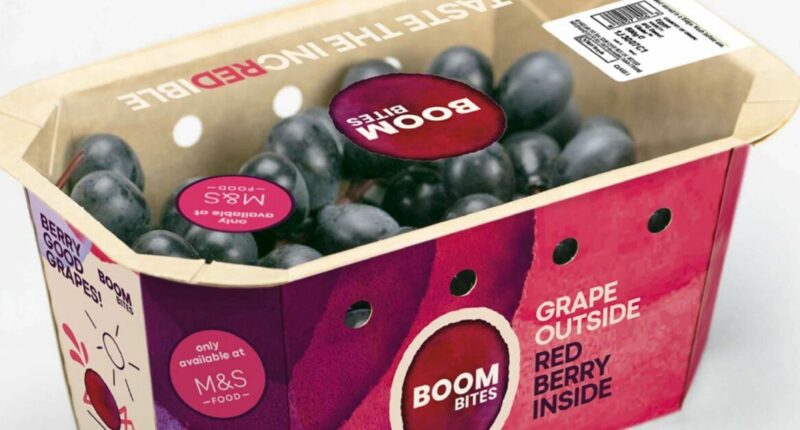Share this @internewscast.com
The introduction of a new red berry grape variety, called Boombites, is set to transform the way we snack. These grapes feature a black exterior with a rich, red interior, contributing to their impressive nutritional benefits.
The distinctive color results from high concentrations of anthocyanins, the potent antioxidants responsible for the blue hue in blueberries and their acclaimed superfood status. Moreover, these new grapes not only boast antioxidant levels comparable to blueberries, but they also contain substantial amounts of resveratrol, another beneficial anti-inflammatory antioxidant.
Resveratrol is commonly believed to be the key factor behind the so-called ‘French paradox’ — the observation that France experiences low rates of heart disease despite a diet rich in saturated fats and wine consumption.
The Boombites grape was developed by cross-breeding traditional wine grape varieties with red flesh and high resveratrol levels with some of the most flavorful table grape varieties. The development process involved experimenting with thousands of different combinations of small, soft wine grapes and large, sweet, crunchy seedless table grapes to produce the unique red berry variant.
This meticulous cross-breeding process involves separating the male component from one plant’s flowers before they can pollinate, followed by gently using a fine brush to introduce pollen from the selected parent plant. Due to the intricate nature of this process, Bloom Fresh—the company responsible for these grapes—often hires individuals with embroidery backgrounds for this specialized pollination task.
After pollination, the immature grape clusters are covered to shield them from airborne pollen from other grape varieties, ensuring the integrity of the cross-breeding process.
The same technique is being used to develop fruit and vegetable varieties with increased resistance to pests and climate change as well as even healthier varieties of fruit and vegetables. Tests by researchers at the Spanish University of Murcia showed the new Boombites have three times more resveratrol than blueberries and comparable levels of antioxidants.
Dietitian Nichola Ludlam-Raine a member of the Red Berry Grape Advisory Board – an expert panel set up to explore the science and health benefits of grapes and new varieties — says: “Blueberries are widely recognised as a superfruit thanks to their high antioxidant levels, and regular consumption is linked with a reduced risk of cardiovascular disease and type 2 diabetes, so it’s great that now we also have a red berry grape variety that’s naturally sweet and crunchy, offering comparable levels of antioxidants and an impressive amount of resveratrol, providing another delicious option for supporting health.”
The Murcia researchers also found the grapes hit a surprising metabolic sweet spot. Despite having similar amounts of natural fruit sugars, they showed much lower glucose uptakes than standard varieties. Dr Nisa Aslam, a GP on the Red Berry Grape Advisory Board, says: “This means that while new red berry grapes are sweet to taste, the combination of phenols they contain alters the way that these sugars are transported and absorbed in the gut.
“This may have major implications for weight control, insulin response and dietary advice around fruit consumption, with consumers restricting intakes of fruits rich in antioxidants because of concerns about sugar.”
New consumer research confirms 60% of adults have tried to cut back on sugar and another 10% know they should. Around seven in 10 also considered monitoring the glycemic index, or GI, of the foods they eat so they can gauge how rapidly sugars go into their bloodstream.
Dr Aslam adds: “Glucose metabolism is also closely linked to the cardiovascular system and some experts believe it should be recognised as an independent risk factor for heart diseases and the circulatory system.”
This metabolic edge is thought to stem from the new red berry grapes having such high levels of antioxidant polyphenols coupled with fibre and other nutrients. The total package is known as the ‘food matrix’, a concept now an increasingly hot topic among scientists looking at diet and health.
Nichola explains: “The food matrix is simply the physical structure of the foods we eat, how this influences the way we absorb different nutrients – and how this can be altered when food is processed rather than eaten in its natural form.
“For instance, we absorb more calories from ground or chopped nuts as we do from eating the same quantity of whole nuts.”
- Boombites are available in Marks & Spencer and Ocado for a limited time only. Visit boombites.com for more information
BOOST FOR HEART HEALTH
Antioxidants are associated with a wide range of health benefits, but studies suggest polyphenols – such as the anthocyanins which give the new grapes their distinctive red flesh – are particularly important. Population studies show eating a diet packed with polyphenols reduces the risk of cardiovascular (CVD) disease – which affects 7.6 million people here – by 46%.
This is thought to be due to multiple benefits including reduced oxidative stress and inflammation and improvements in blood cholesterol, clotting and endothelial function, the term used to describe the elasticity of blood vessels. Anthocyanins, the polyphenols which give blueberries, acai berries and goji berries their deep purple colour and superfruit status, have proven cardioprotective properties.
They could prevent CVDs through their lipid-lowering and anti-inflammatory properties. A study in the Frontiers in Nutrition journal concluded eating anthocyanin-rich berries regularly “could prevent cardiovascular diseases through their lipid-lowering and anti-inflammatory properties”.
Resveratrol is the antioxidant thought to explain health benefits associated with red wine, and is also found in fruits including grapes and blueberries. A super study combining 13 trials involving more than 209,000 people, showed wine drinkers had a 32% reduction in the risk of heart disease and stroke, compared to non-drinkers.












